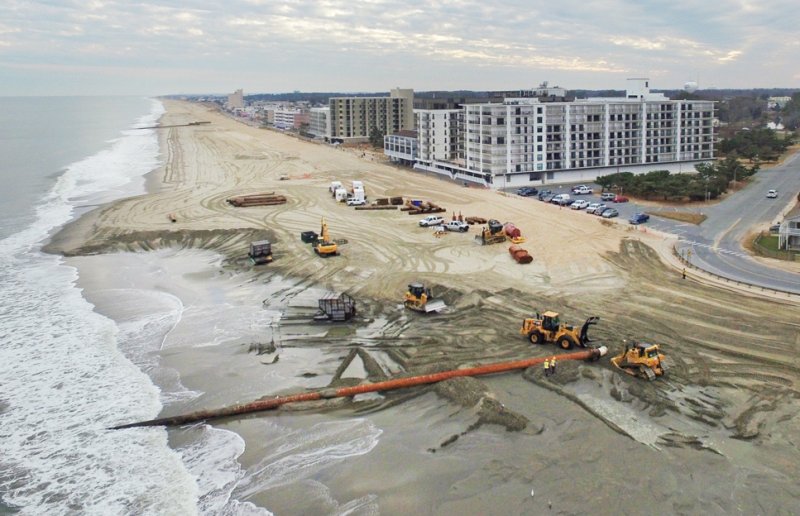No extra sand for First State in 2025
Since 2009, there have been half a dozen large-scale beach nourishment projects along Delaware’s ocean coastline.
Local officials were expecting another round of nourishment to take place this winter, but it appears that will not happen because the federal government hasn’t funded its portion of the project under the existing operating budget. It may not happen in 2026 either, said Tony Pratt, during a Rehoboth Beach commissioner workshop July 7.
Now a consultant for local beach communities, Pratt worked for the Delaware Department of Natural Resources and Environmental Control for decades before ending his career in 2018 as Shoreline and Waterway Management Section administrator.
Pratt described the situation as worrisome. He said the point of periodic replenishment is to keep dunes built up to a level where they continue to protect infrastructure and provide recreational activities. The dunes aren’t in bad shape now, but one big storm could change all that, he said.
The beach towns aren’t in crisis mode, but they’re looking at it, said Pratt.
The U.S. Army Corps of Engineers oversees the implementation of replenishment projects.
Army Corps spokesman Steve Rochette confirmed Pratt’s comments, saying replenishment along Delaware's coast is due for periodic nourishment, and it is still eligible, but the funding for 2025 didn't come.
The president's draft budget for next year also doesn't include funding, but the funding for nourishment typically is not included in this draft, said Rochette. The budget still has to go through the congressional marking-up process, and the Army Corps hasn’t seen the House and Senate versions of the budget.
Michael Globetti, DNREC spokesperson, said the Army Corps has estimated the total project cost will be $22.25 million, with a $17.8 million federal share and a $4.45 million non-federal cost share, which means the state’s share. The Army Corps has $9.8 million allocated for its share, but has not identified or been allocated the remaining $8 million, he said.
Globetti said DNREC and Gov. Matt Meyer’s office have submitted to Delaware’s congressional delegation a Congressionally Directed Spending request for next year to assist with the cost, but that is subject to the congressional budget process.
Recognizing how important the beach is to Rehoboth’s economic well-being, city officials are concerned. Mayor Stan Mills said the dune is in OK shape, but the city is one big storm away from being in trouble.
Questions linger over local funding
It’s still unclear where the local funding would come from.
To date, funding for the replenishment projects has been 65% federal and 35% state. The state funds its portion of beach replenishment two ways: 1% of the state’s 8% lodging tax and through bond bill appropriations by the General Assembly.
Pratt said one of the last things former Sen. Tom Carper did was get the funding to be 80% federal and 20% local. This cost-sharing percentage is represented in the breakdown of costs previously stated.
At the beginning of last year, DNREC announced funds for the state’s portion of beach replenishment would dry up in five years under the 65/35 cost-sharing method. To address those concerns, the agency conducted an economic analysis for shoreline management. Report results, released during a meeting in the fall, recommend ocean and bay communities pay 50% to 75% of the costs associated with beach replenishment projects.
Pratt said he had issues with the report because it appears to be focused on a presumed outcome. It wasn’t a fair evaluation of what benefits the state receives from beach replenishment, he said.
Using a picture of the Rehoboth Boardwalk from early 2005 that shows 10 to 12 feet of dry sand at high tide, Pratt said it’s not just about the immediate economic impact, but also about cost avoidance and what hasn’t been spent because of the dune. If replenishment hadn’t been taking place, the Boardwalk would be gone and the first row of adjacent structures would be damaged, if not wiped out.
Also, the state park beaches aren’t receiving replenishment, but they’re growing because of natural sand movement along the coastline, Pratt said.
Mills and representatives from other ocean communities have said before they believe DNREC has sole authority to maintain Delaware’s beaches, and it should be responsible for funding the projects. His opinion hasn’t changed.
These ocean communities don’t have deep pockets, said Mills.
Pratt provided information from a recent University of Delaware study called Seaside to Statewide: The Economic Contributions of Delaware’s Coastal Region. It was written by James Rising, associate professor of marine policy, and Caitlin Wilson, a PhD student in marine policy. The report provides an updated evaluation of the economic significance of Delaware’s coastal economy. The report says, as of 2022, the direct contribution of Delaware’s coastal activities resulted in more than 74,000 jobs, more than $4 billion in labor income, almost $8 billion in value added and a little more than $14 billion in industrial input. The numbers all increase when indirect and induced activities are considered.
In terms of taxes, the report says coastal activities generate more than $3.3 billion in economic activity, with $210 million going to local governments, $820 million going to the state government and $2.3 billion going to the federal government.
DNREC’s report on cost sharing was conducted under a previous gubernatorial administration and DNREC secretary. Greg Patterson was named DNREC secretary in January. He hasn’t publicly commented on the funding study or if its results will affect funding in the future.
Globetti said there is no current DNREC proposal for local cost share.
Chris Flood has been working for the Cape Gazette since early 2014. He currently covers Rehoboth Beach and Henlopen Acres, but has also covered Dewey Beach and the state government. He covers environmental stories, business stories and random stories on subjects he finds interesting, and he also writes a column called Choppin’ Wood that runs every other week. He’s a graduate of the University of Maine and the Landing School of Boat Building & Design.























































